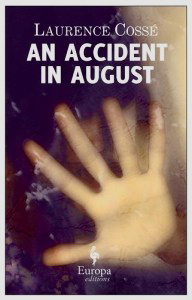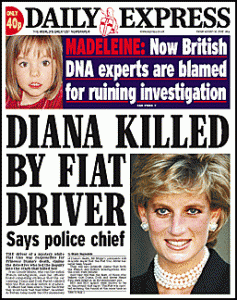“It was death she had run away from, of course, on Saturday night, death with its horrible sounds, death by twisted metal, slicing, slashing, tearing. Death searing through white flesh, blood spurting. And now she was trying to hide from death.”
 Released to coincide with the fourteenth anniversary of Princess Diana’s death on August 31, 2011, this newly translated novel by Laurence Cosse will attract many of the readers who enjoyed her best-selling A Novel Bookstore, from 2010. In this novel, originally written in 2003, the author picks up one of the remaining mysteries from the investigation of Princess Diana’s death and creates a novel around it—a witness’s report of a slow-moving car which the Princess’s speeding Mercedes grazed at the entrance to the Alma tunnel where the fatal crash occurred. The slow-moving car was described as a white Fiat Uno.
Released to coincide with the fourteenth anniversary of Princess Diana’s death on August 31, 2011, this newly translated novel by Laurence Cosse will attract many of the readers who enjoyed her best-selling A Novel Bookstore, from 2010. In this novel, originally written in 2003, the author picks up one of the remaining mysteries from the investigation of Princess Diana’s death and creates a novel around it—a witness’s report of a slow-moving car which the Princess’s speeding Mercedes grazed at the entrance to the Alma tunnel where the fatal crash occurred. The slow-moving car was described as a white Fiat Uno.
Readers of this novel will learn that the driver, as the author imagines her, was Louise Origan, a young woman living, not quite happily, with her boyfriend Yvon, on her way home from work at a restaurant in Paris. Panicked when the Mercedes crashes, Lou never stops, and on reaching the safety of her home, she relives her actions: “I never thought of stopping, not one second. I was running away. It was my foot that decided, or fear, in any case something that isn’t like me.” It is not until the next morning that she learns who the victims of the crash are, and though she may have contemplated going to the police to admit involvement in what she thought at first was an “ordinary” accident, she realizes that “there was no way she could go to the police now.” The media circus wouldn’t be just “a rough patch” for a few weeks, she knows. “You’re in it for life,” she realizes. “You are marked…For all the days you still have to live, you’ll be the girl who caused Diana’s death.” She tells no one.

Over the next few days, Lou is consumed with guilt, but at the same time she is doing everything she can possibly do to avoid being identified, eventually making herself sick with worry. She reads newspapers compulsively to find out whether the police have any more information from the dozen or so witnesses to the accident, whether her car and license number have shown up on the cameras in the tunnel, whether there is any record on radar, whether the make and model of the car have been identified, and whether Trevor Rees-Jones, the Princess’s bodyguard and the only survivor, is able to tell the police anything about the brush with her car. He represents, for her, “A time bomb…How soon would it explode?” she wonders.
Two weeks after the accident, the by-now terrified Lou makes some dramatic decisions and then acts, her self-protective behavior so shocking that it cannot be described without involving spoilers. It is this behavior and its consequences which form the bulk of the novel.
 As a main character dealing with a crisis of conscience of this magnitude, Lou conjures up the reader’s worst nightmares, and the author plays on those, making the nightmares and the guilt worse and worse over time, so that the reader cannot help wondering “what if…?” For the reader to identify with Lou and feel empathy toward her, however, the reader must also be able to imagine making the same choices that Lou makes–to run away from the moral obligations which one human being has toward another human being when that person needs critical help. This moral obligation is regarded as so important to society that France has even made it a legal requirement. (A person responsible for an accidental death may get three years in prison, but a person who fails to render assistance after an accident like this one may get five years.) Since we know that Lou might have turned herself in to the police if the victim had not been the princess, the reader must believe that Lou’s fear of the paparazzi is so great (and so well justified) that her actions are not only understandable but also a reason to sympathize with her.
As a main character dealing with a crisis of conscience of this magnitude, Lou conjures up the reader’s worst nightmares, and the author plays on those, making the nightmares and the guilt worse and worse over time, so that the reader cannot help wondering “what if…?” For the reader to identify with Lou and feel empathy toward her, however, the reader must also be able to imagine making the same choices that Lou makes–to run away from the moral obligations which one human being has toward another human being when that person needs critical help. This moral obligation is regarded as so important to society that France has even made it a legal requirement. (A person responsible for an accidental death may get three years in prison, but a person who fails to render assistance after an accident like this one may get five years.) Since we know that Lou might have turned herself in to the police if the victim had not been the princess, the reader must believe that Lou’s fear of the paparazzi is so great (and so well justified) that her actions are not only understandable but also a reason to sympathize with her.

As Lou acts to guarantee that she will not be discovered to be the driver of the car, the action becomes increasingly melodramatic–and sometimes absurd. Lou becomes more calculating as the novel progresses, able to take very carefully considered actions in her own self-interest during times which would terrify any rational person (or reader). The style of the narrative gradually becomes faster and more intense, but when the surprising climax does occur, it is dealt with in fewer than seventy-five words, after which Lou carries on as she has been doing, without a backward glance.
If Lou, under the same exact circumstances, had been involved in the death of an anonymous teenager out for a joyride, however devastating that would have been for the victim’s family, I do not believe this book would have found an audience, and I am sad that the death of Princess Diana was used as the crux of this sensationalized novel. It does allow the author to explore behaviors that Lou herself indicates might not have been an issue if the victim had been anyone else, but is that enough to justify its use? Important books gain their weight and significance because of the universality of their themes and the unique ways in which the author develops them, often through their characters, but for me, Lou is much too weak a character to give us those insights–she thinks of nothing except her own escape. Her concluding statements will not endear her to readers expecting more, making the book’s release, especially on an anniversary of the Princess’s death, feel more than a little exploitative.
Photos, in order: The author’s photo is from http://www.musanostra.fr
The white Fiat Uno is shown on http://www.sahibinden.com
Also by Laurence Cosse: A NOVEL BOOKSTORE
